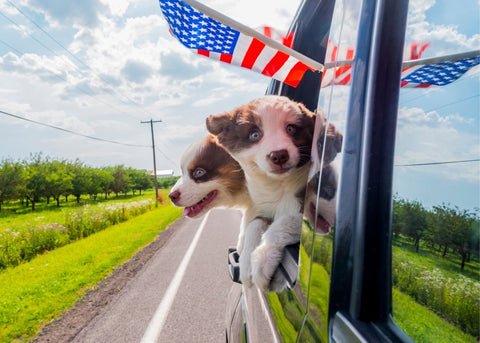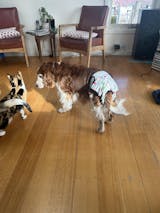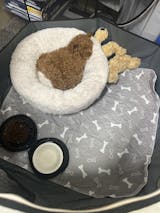Dog Car Travel - Step by Step Guide to Train Them
You've got a new puppy and can't wait to show it around. We understand how you feel! But, before you start planning that epic road trip (or even getting ready to drive to the vet), keep in mind that a car can be a strange thing to a puppy. For a puppy that isn't used to travelling, the enclosed area, car movement, and even the engine sound can be frightening. However, you can do a few things to make vehicle rides more bearable for your dog. Who knows, they might even begin to look forward to them! Here are the fundamentals of puppy automobile travel.
Can Puppies Travel In The Car?
Yes, puppies can take a car trip, but each dog will have a unique experience.
The majority of pups enjoy hopping in and out of vehicles, but some are apprehensive about the experience. Fortunately, there are numerous things you can do to make your four-legged pal feel more at ease.

The key to transporting your dog in a car is to instil confidence in them. The more assured they are, the more they will be at ease and less stressed. The sooner dogs experience travel, like with so many other things, the better. You want your puppy to be familiar with cars as soon as you bring them home.
Puppy Doesn't Like Car Rides- Is it True
While some pets enjoy automobile rides, it's reasonable that others acquire a phobia of them. In addition, many automobile excursions result in visits to the veterinarian for vaccinations and uncomfortably cold thermometers implanted in awkward places.

You may wish to calm your terrified pet, but avoid imitating the sounds he is making. When you make what you believe are relaxing, sympathetic sounds, your dog may interpret them as its whining. You may be reinforcing the fact that car drives are challenging and frightening even for humans, giving your puppy an excuse to continue complaining.
Dog Sitting in The Car - Are They Anxious?
There could be several reasons your dog cannot rest in the automobile. Let's look at a few of the most common.
He becomes vehicle sick. This happens more frequently than you might imagine! Consult your veterinarian about running a trial run with anti-nausea medicine, especially if your dog is a puppy or is new to you. Anti-nausea medications are safe, and your issue is resolved if they work! However, it's likely that your dog began feeling queasy and is now feeling nauseous and nervous, in which case you may still have to work on feeling happy in the car emotionally.

She's looking forward to seeing where you're heading. If your dog is pacing and whining in the back of the car or barks incessantly while you drive and pull into a parking spot, you may have an overly excited pet! It would help if you worked on training these pups to moderate their emotions and take them to a lot of dull areas. If your dog realises that you're usually simply driving around the block or heading to the grocery store, she'll stop freaking out. Putting in a lot of practice time with these pets is also critical. If your dog only gets in the car a few times a year to travel to her favourite spot in the world, she'll go insane with excitement! The desensitisation procedure indicated below may not be as effective for some canines.
He's concerned about your destination. Another typical reason your dog may struggle to relax during the ride. If he's scared that you're on your way to the vet, groomer, or boarding facility, and your dog doesn't like such locations, the car will begin to smell bad! Use the method below to help your dog relax, and be sure to take your pup to lots of exciting locations! He'll feel a lot better if he knows you're going for a walk by the river rather than to the vet.

She's paranoid about the objects flying by the window. Covering your dog's box will often fix the problem - it only becomes more difficult if you can't fit a crate in your car. This is one of the more complex types of automobile anxiety to overcome because it isn't about the destination—the motion of the items passing by causes this type of automobile anxiety. You'll want to go through the technique below, but you'll also need to work on lessening your pup's anxiety in general.
Something unpleasant happened during or after a car ride, and your dog is now afraid. If you've recently been in a car accident or otherwise terrified your dog during or after a car journey, she may be fearful of the car. The treatment outlined below will help the majority of these pets recover.
Dog Car Travel - Safety First
The first year of your puppy's life is filled with many firsts, such as puppy training for basic instructions and obedience, a trip to the veterinarian, and developing a close relationship with your family. Considerable activities come naturally to a puppy, while others require practice and patience.

Take these precautions to safeguard your puppy's safety before the first dog car travel.
Use a Crate, Harness, or Car Seat to keep your puppy safe!
Allow your dog to roam freely in the car or sit in your lap. Not only can it be incredibly distracting for the driver, but it can also be very dangerous for your dog if you have to stop short. You'll want to ensure they're safe by putting them in a kennel, attaching their harness to a seatbelt, or using a doggie car seat.

While having your puppy in the front seat is appealing, the safest place to keep your dog is in the rear seat of your car, which also helps you avoid a potential distraction while driving!
Always keep the head and paws inside the car
Open automobile windows, especially while driving, can be quite dangerous. We know that many dogs enjoy looking out the window, but a severe risk is associated. Their eyes may be impacted by dirt and debris, high winds may harm their ears, and puppies have been reported to fall out or even jump out of moving cars.
Keep your puppy safe inside the car and crack the window a few inches instead of enough to bring in the fresh air, which can also benefit them if they get car sick.
Dog Sitting in The Car - Make Them Comfortable
A trip to the vet is often the major reason that many dogs get to ride in the vehicle. As a result, many dogs associate car rides with vet visits. This is known as "classical conditioning". And, given that many dogs don't always enjoy going to the vet, is it any surprise that getting in the car can sometimes cause tension and anxiety in so many pets?

Other dogs get uneasy in the car due to previous poor car experiences, such as being left alone or seeing a frightening occurrence, such as a car accident.
The good news is that if you start early, you can use a process called desensitisation to prevent your dog from ever creating negative associations (and the resulting stressed state of mind) with the car. If you already have an anxious dog during car rides, you can use counterconditioning to change that relationship. Recognising that it is not a race is essential for desensitisation and counterconditioning. Slow down. Baby steps increase the likelihood of success.
Desensitising a Puppy to Enjoy Riding in the Car (Prevention)
Begin with the dog sitting in the car. Leave the car parked and switched off. Sit close to your dog in the location where you intend to ride them regularly (we recommend the back seat or cargo area with proper travel safety restraints). Pet, praise, cookies... whatever your dog enjoys! Do this for no more than a few minutes at a time.
While your dog remains in their kennel, gradually introduce driving while still in the neighbourhood. You can reward them with treats and praise them when they are quiet and peaceful. This is an excellent opportunity to use a stuffed Kong or Toppl to create a positive link between remaining calm and moving away from you in the automobile.
After you've practised with the car switched off, begin to introduce turning it on. Maintain neutral energy and attitude while you turn on the car, wait a bit, and then turn it off. The noise can be unsettling at first, so toss a treat as soon as it occurs. Extend the time you keep the engine going while keeping your pup calm and pleased with verbal praise and the occasional treat toss.

Don't be alarmed if you experience a fear response during this process! Your dog may rear up, press its ears against its head, or have a closed mouth and wide eyes. They are stressed if you notice them avoiding moving closer, moving further away from the automobile, or attempting to leap out. Other minor stress cues include yawning, lip licking, and what are known as "displacement behaviours."
Displacement behaviours, which include sniffing the ground, self-grooming, licking, sneezing, and scratching, are ordinarily typical actions performed out of context when your dog is emotionally conflicted. Maintain cheerful energy to show your pet that there is nothing to worry about and to provide some comfort. Then take a step back or reduce the intensity of your step.
Begin to incorporate more of the car journey procedure, being sure to promote calm behaviour with praise and goodies at all times. Reverse out of the driveway before returning, or take a quick journey around the block before making longer and longer trips. Take your puppy to many enjoyable places where they can learn that car rides foretell great things!
Counterconditioning Your Anxious Dog to Feel Better About the Car (Treatment)
The counterconditioning stages are related to the desensitisation steps stated in the preceding process. The main distinction is that your dog associates being in the car negatively as opposed to a puppy who, when you first introduce them to the vehicle, hasn't formed any associations (positive or negative). As a result, in these steps, you should concentrate on rewarding your dog's decision to move towards the car.

Don't try to entice them with a toy or treat or use leash pressure to bring them closer. Their trust in the car will grow if they are given the option of approaching or getting in the car, and that option is rewarded with things they enjoy. The more a decision is rewarded, the more frequently it will be made. Patience is crucial!
Begin slowly: Some dogs need to start this process before getting into the car. If your dog is extremely anxious and begins to stress before getting in the car, start outside the parked car. Give them a treat and praise every time they look at the car! Treat and praise them if they step towards the car; alternatively, if they enjoy toy play, play tug with them near the car. Do this for a few minutes at first, or even a few seconds, depending on how stressed they are around the car. For a few weeks, do this everyday or every other day.
Build Confidence: After that, you can open the car door and carry out the same procedure of rewarding people highly for approaching and looking at a car. Instead of shoving them inside the car, encourage them to go to the open door on their own before rewarding them.

Reward Continued Progress: Once they've demonstrated more confidence in reaching the openings, you can incorporate the stage of jumping in (or being picked up and placed in the car, if they're small enough). When they place their feet in the car, lavish them with praise and a special treat, and then, if they so choose, allow them to exit the vehicle (or remove their feet) immediately. Rehearse this move until your dog is comfortable getting into the car and does not immediately want to get out.
Sit in the Back Seat With Your Dog: Take your dog into the back seat (or cargo area) with the car parked. Pet, praise, and reward them with high-value treats (like little pieces of cheese, hot dogs, or whatever you know they love).

Build Duration: Slowly extend the time you and your passenger spend in the vehicle. Alternatively, sit calmly next to them while you pat and praise them or consider feeding them regular meals in the car.
Car Sickness in Dogs
Although several dogs eventually overcome it, car illness in puppies is very frequent. If your pet gets car sick, it's a good idea to put down waterproof sheeting in which they tend to sit or lie and to keep plenty of paper towels and cleaning spray on hand in case they get sick.

A car-sick puppy is an unhappy puppy, which no one wants, so don't travel when they're full. As a precaution, avoid feeding your dog for two to three hours before you travel, and always take your dog for a walk right before you leave so they aren't worried about having an accident. If car sickness becomes a regular occurrence, consult your veterinarian.
Always exercise patience and strive for steady advancement. As soon as the door closes and the engine starts, your puppy will be accustomed to the vehicle and know what to anticipate: a wonderful journey with a beloved travel companion and lots of off-key singalongs.
Stay Safe And Sound With Dry Paws
We hope that our efforts make life with your dog easier for you! We have some excellent dog products. All of these items are simple to use, washable, and environmentally friendly. Your pet will be much happier as a result. We have a variety of sizes available, so no matter what size your dog is, he can rock in dry paws products.
















